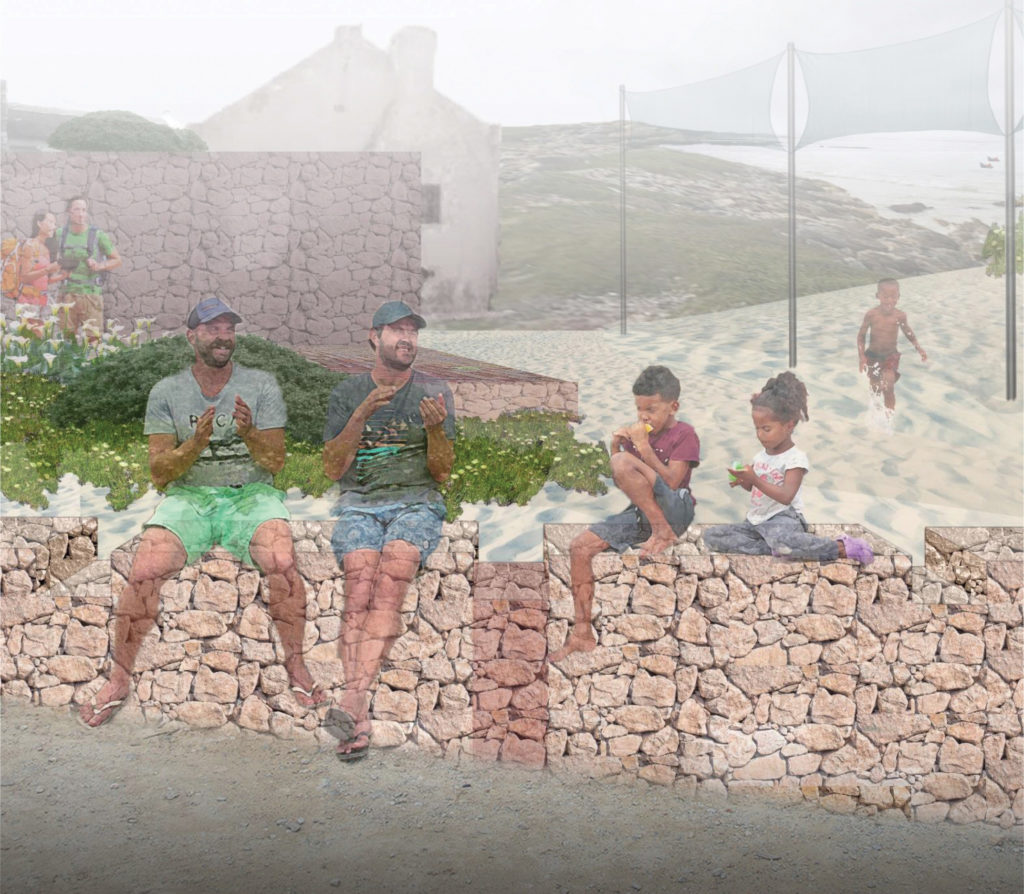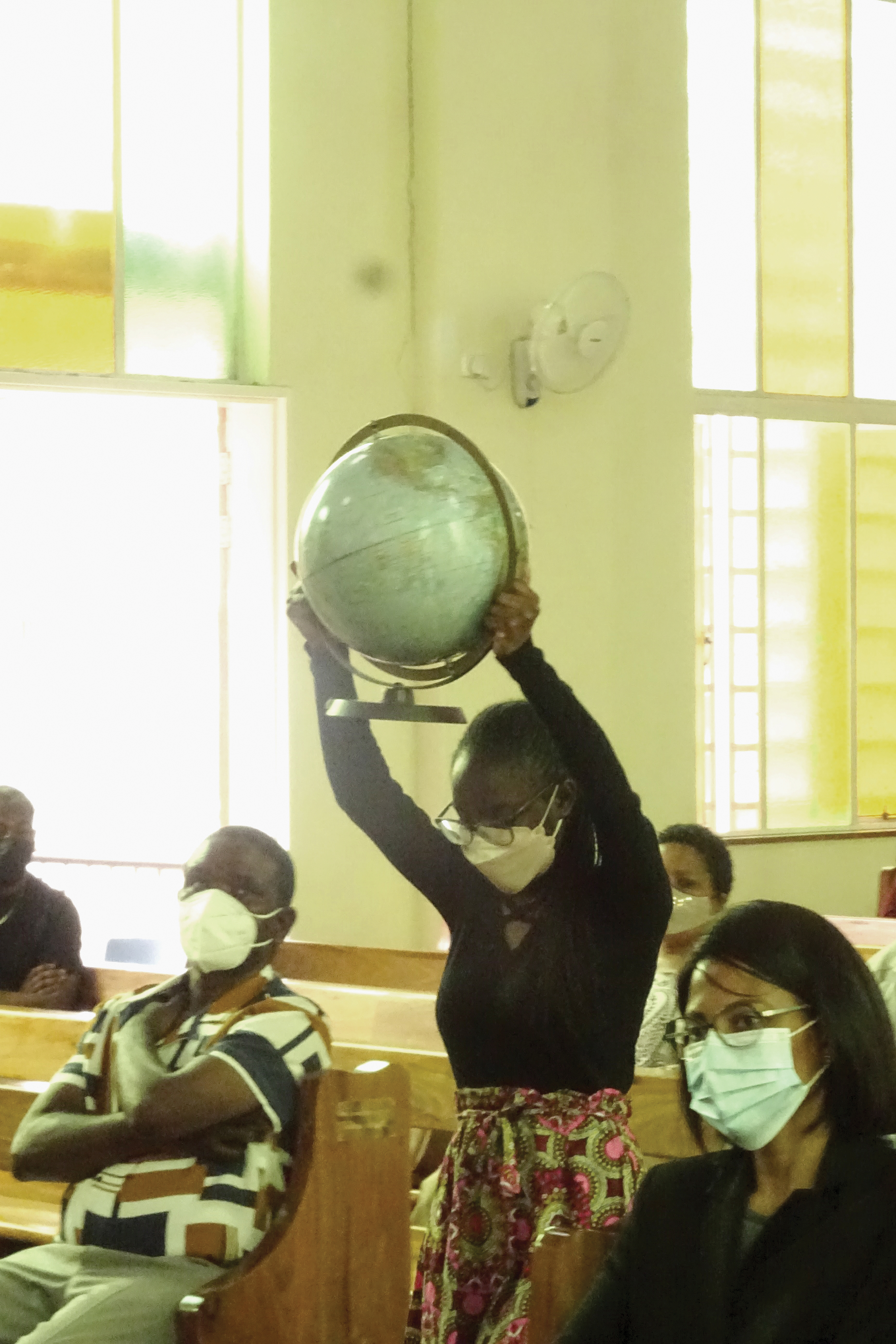YOUTH VOICES • ECO-CREATIVITY

LET’S BE REAL
The environmental crisis we are immersed in demands creative thinking. The author of this article, a young landscape architect, presents an eco-friendly proposal for transport and an innovative solution for water catchment at rest shelters in Arniston, a small village in the Western Cape of South Africa
BY JILL A. WILLIAMS | CANDIDATE LANDSCAPE ARCHITECT, PRETORIA
GENERATION Z (those born from 1997 onwards) has shown that they are after more than words, tradition and plans. They want meaningful action that will lead to meaningful results. Gretha Thunberg, the well known Swedish climate activist, showed this in her talk at the opening plenary session of the Youth-4Climate event on 28 September 2021 in Milan, where she pointed out the discrepancies between the words used by various political figures and the promises they had made to help reduce the impact humanity has on the environment: “This is all we hear from our so called leaders: words, words that sound great but so far have led to no action, our hopes and dreams drowned in their empty words and promises,” (AFP 2021, September 29). At this event, COP26 was determined to be crucial in concretizing the 2015 Paris Agreement, which aw countries “commit to limit global temperature rises to ‘well below’ 2ºC (AFP 2021, September 29). According to this source, no clear plan of action or funding model for this has been worked out yet.
Real change comes in designing for the simple moments that everyone can relate to
Another young activist, Vanessa Nakate, a Ugandan who campaigns for climate justice for vulnerable communities, also took part in this event. Her contribution to this discussion was that, “we cannot eat coal, we cannot drink oil, we cannot breathe gas,” (AFP 2021, October 4). She has shown how fossil fuel dependency can be diminished in her Vash Green Schools project where solar panels and green ovens were installed in rural schools to replace traditional woodfired stoves that had a negative impact on the environment (AFP 2021, October 4). Projects like these can make a difference in the grand scheme of things, even if just by a microgram. If this is what it takes for the green movement to gain momentum and to be taken seriously, then we can and must play our role—in every sphere of our lives.
Active participation
The youth within various faith communities have also taken on the challenge. The SACBC Interdiocesan Youth Go Clean programme has been running for a number of years and has recently promoted
the Season of Creation, a month in which Catholics prayed and acted in practical ways to help care for creation. Weekly Facebook live talks were held on various topics, including Embracing Mother Earth, which was about waste management. Each day in the month of September/October, a challenge was posted on Facebook by the SACBC Youth & Young Adults Ministry to prompt youth to show how they promote sustainable practices in their daily lives. One such prompt, on day 22 was, ‘Walk instead of driving’. Imagine the amount of carbon reduction that would be possible if every Catholic stood together on that day and took up the challenge!

The sign held by the girl says ‘Basta blah blah blah’ which means ‘No more blah blah blah’.
Source: Mænsard vokser/commons.wikimedia.
Another example I experienced firsthand, was at the Taizé Pilgrimage of Trust that took place in Cape Town in 2019. Each day we would have workshops and talks in smaller groups at local churches, and afterwards we would join all the pilgrims for further workshops, activities and Mass at the main venue: a tent set up on the field at St Joseph’s Marist College. Lunch and dinner were usually served to the nearly 4000 attendees at this main venue, and the major task of the collection of food scraps, the washing of dishes and general refuse management was taken on by the Green Anglicans, amongst others. This event happened on the back of a very critical period in Cape Town—the looming fear of reaching a day when all taps would run dry—the infamous Day Zero. Waste was categorized into separate bins for paper, plastic, glass and natural/ food waste. That was not all. Large skottels or washing basins with water to pre-rinse, wash and rinse one’s dishes were available for each participant to wash their dishes after meals. This grey water would then be collected in large storage tanks, to be re-used for some other purpose unknown to me (I supposed it would be cleaned or treated for re-use, possibly in irrigating the massive field). Taps were also made available strictly for use when filling one’s water bottle (volunteers were on standby to ensure no wastage occurred). I appreciated how protective they were over water.
It was the first time I had heard or seen of a faith-based group actively taking part in helping to reduce the effects humans have on the climate. I trust that it won’t be the last. A prayer service, in preparation for COP26, organized by the Green Anglicans, among other denominations and various Christian movements from Africa, can be found in the following link: https://youtu.be/E_uRQ4n-C1E.
Designing our future
As effective as this small-scale change is and can be for our future, it is also very important that we actively design for the future hoped for. I found that this is possible in practical and innovative ways, in conducting research-by-design for my dissertation, Between seeing and living: a series of landscape interventions, for enhancing the living heritage of Arniston/ Waenhuiskrans (Williams 2020), submitted in partial fulfilment of my Masters in Landscape Architecture.

Landscape Architecture understands the various layers that make up how humans interact with the environment.There are even layers to our existence, literally seen when archaeological expeditions uncover a piece of pottery or a tool from the Stone Age—the layering of strata of a soil profile or the rings displaying the age of a tree, all the way down to a grain of sand on the beach, which was once part of a mountain, or the shell of a mollusc.
The earth is made up of various landscapes and land forms, which are constantly changing and being moulded by everything that happens around us and our very own impact on it, resulting in Climate Change. Such is the case in Arniston, a coastal fishing town in the Western Cape Province in South Africa. It hosts two grade ii provincial heritage sites listed under the South African Heritage Resources Agency (SAHRA), one of which is a fishing village (SAHRA, no date), a shipwreck, a cave and many other sites of importance to people in the area and to the history of the country. The town has a rich ‘living heritage’, which The International Centre for the Study of the Preservation and Restoration of Cultural Property (ICCROM) describes as spaces where heritage and people are continually a part of one another’s daily living and functioning, in the community of place (Court 2015).
It is also very important that we actively design for the future hoped for
The town’s location along the coast, which is very visibly a place of transition and forces impacting upon each other, echoes the pattern seen in the way people (tourists and residents) move in and out of the town (even throughout history) and how they move within it. Currently, however, tourists would drive to all the major attractions, despite the fact that the town spans a radius of no more than one kilometre, and will remain so in the future, as any new developments are to happen within the existing urban edge, as specified in Cape Agulhas Municipality’s Spatial Development Framework (2017). By utilising non-motorised transport, i.e. cycling and walking to places of importance, tourists (both local and international) would be able to engage with the heritage of the town more effectively and will have more of a chance to engage with the residents of the town, who also form part of the living heritage.
In harmony with the environment
The proposal made was that of a movement sequence with a series of sheltered gathering spaces as the basis of a route taken to reach the sea, where one is able to prompt the tourist, whether local or international, to interact with various heritage, economic and social places of importance within Kassiesbaai (the heritage village within Arniston with quaint fishing houses from the 1800s that are still in use) and the town as a whole. Essentially, the basis of this proposal is the promotion of non motorized transportation, which would greatly reduce the carbon footprint of the town, particularly during peak tourist seasons.
Solar panels and green ovens were installed in rural schools to replace traditional wood-fired stoves
Zooming into this pathway to the sea, one finds sheltered spaces where one can rest, drink water or just take in the amazing atmosphere and view. This is accommodated for in the form of a seating wall or stair; shading, provided by a tree or wall, as well as water that can be accessed from a font within that wall. This water is sourced from the air and is channelled into a storage tank, also located in the wall, the thickness of which allows water to remain cool and prevents evaporation back into the air. This region is the perfect testing ground for a fog harvesting system, due to its strong winds as well as regular fog and mist occurrences (University of South Africa (UNISA) 2008). In fact, this form of water harvesting would greatly benefit any community, whether they are located in an arid, tropical or coastal region. Air simply moves through a wire mesh or strands (harp), and the microscopic water droplets in the atmosphere get caught onto this steel surface, collect and form larger droplets, and then move down the surface via gravity to a collection tank. Depending on the climate of the region and the design of the system, as well as the budgetary constraints of the project, one could use sophisticated wire nets or harps, or simply a fishing net or fishing gut, as is typically found in Kassiesbaai. The aesthetics of this system therefore took its cue from another design informant in the area: the lines put up next to the homes in Kassiesbaai to dry laundry or fish. From this, a newly introduced system could find its grounding in an archetypical element that is recognizable to the residents and would therefore very likely be used and welcomed into the community. Oftentimes, masters students start off believing they can save the world through their designs, but are humbled in the process when they realise that in the end, all that time and energy spent was probably something only a limited group of people would see or know about. It is mostly a way of shaping one’s own way of thinking and doing things. I realized, with the help of my supervisor, that sometimes, doesn’t come from an amazing 5-star, beautifully rendered design that will take trillions of dollars to realise—or a grandiose system planned to consume all the excess carbon we have pumped into the air—but rather that in designing for the simple moments that everyone can relate to, (such as how to quench one’s thirst after a long walk) one can prompt meaningful change, a real difference.
